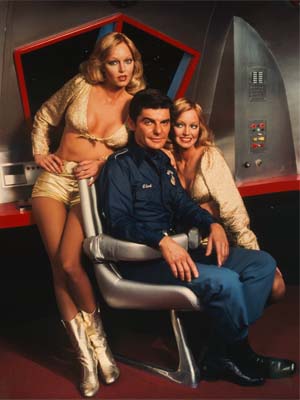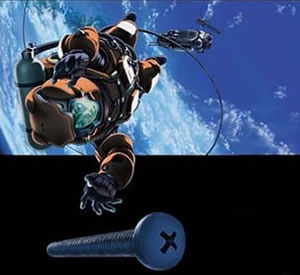Science Fiction
Dictionary
A B C D E F G H I J K L M N O P Q R S T U V W X Y Z
CleanSpace One Goal: De-Orbit Space Debris

CleanSpace One is an experimental technology to be deployed by EPFL (École polytechnique fédérale de Lausanne), one of Switzerland's Federal Institutes of Technology. The intent of the program is to provide a small-scale, lower-cost technology to rid near-Earth space of thousands of pieces of deadly debris - space junk.
The following CleanSpace One video provides a concise explanation of the EPFL's intent.
(CleanSpace One video)
After its launch, the cleanup satellite will have to adjust its trajectory in order to match its target’s orbital plane. To do this, it could use a new kind of ultra-compact motor designed for space applications that is being developed in EPFL laboratories. When it gets within range of its target, which will be traveling at 28,000 km/h at an altitude of 630-750 km, CleanSpace One will grab and stabilize it – a mission that’s extremely dicey at these high speeds, particularly if the satellite is rotating. To accomplish the task, scientists are planning to develop a gripping mechanism inspired from a plant or animal example. Finally, once it’s coupled with the satellite, CleanSpace One will “de-orbit” the unwanted satellite by heading back into the Earth’s atmosphere, where the two satellites will burn upon re-entry.Although its first model is destined to be destroyed, the CleanSpace One adventure will not be a one-shot deal. “We want to offer and sell a whole family of ready-made systems, designed as sustainably as possible, that are able to de-orbit several different kinds of satellites,” explains Swiss Space Center Director Volker Gass. “Space agencies are increasingly finding it necessary to take into consideration and prepare for the elimination of the stuff they’re sending into space. We want to be the pioneers in this area.”
The design and construction of CleanSpace One, as well as its maiden space voyage, will cost about 10 million Swiss francs. Depending on the funding and industrial partners, this first orbital rendez-vous could take place within three to five years.
Science fiction writers of all sorts, in a variety of media, have been sounding the warning about space debris for generations, and placing the solutions into popular culture where they can be part of the lives of engineers and policymakers.
For example, consider the 1977 television series Quark. This comedy, created by legendary writer Buck Henry, described the activities of the United Galaxies Sanitation Patrol Cruiser, an interstellar garbage scow.

(Richard Benjamin and the Barnstable twins)
Richard Benjamin played Adam Quark, who worked to clean up trash in space. He is ably assisted by the Bettys, played by the Doublemint twins (Cyb and Patricia Barnstable).
In his 1978 novel The Fountains of Paradise, Arthur C. Clarke uses Operation Cleanup to make sure that low earth orbit is clear of debris for the newly constructed space elevator.
Fortunately, the old orbital forts were superbly equipped for this task. Their radars - designed to locate oncoming missles at extreme ranges with no advance warning - could easily pinpoint the debris of the early Space Age. Then their lasers vaporized the smaller satellites, while the larger ones were nudged into higher and harmless orbits.
Fans may also recall Planetes, an anime series published by Makoto Yakimura in Japan starting in 1999. The series follows a team of debris cleaners who clear space junk from flight paths.

Planetes cover art
Scroll down for more stories in the same category. (Story submitted 2/17/2012)
Follow this kind of news @Technovelgy.| Email | RSS | Blog It | Stumble | del.icio.us | Digg | Reddit |
Would
you like to contribute a story tip?
It's easy:
Get the URL of the story, and the related sf author, and add
it here.
Comment/Join discussion ( 1 )
Related News Stories - (" Space Tech ")
Will Space Stations Have Large Interior Spaces Again?
'They filed clumsily into the battleroom, like children in a swimming pool for the first time, clinging to the handholds along the side.' - Orson Scott Card, 1985.
Reflect Orbital Offers 'Sunlight on Demand' And Light Pollution
'I don't have to tell you about the seven two-mile-diameter orbital mirrors...'
Chrysalis Generation Ship to Alpha Centauri
'This was their world, their planet —
this swift-traveling, yet seemingly moveless vessel.' - Nat Schachner, 1934
The First Space Warship For Space Force
'Each of the electrical ships carried about twenty men...' - Garrett P. Serviss, 1898.
Technovelgy (that's tech-novel-gee!) is devoted to the creative science inventions and ideas of sf authors. Look for the Invention Category that interests you, the Glossary, the Invention Timeline, or see what's New.
Science Fiction
Timeline
1600-1899
1900-1939
1940's 1950's
1960's 1970's
1980's 1990's
2000's 2010's
Current News
Natural Gait With Prosthetic Connected To Nervous System
'The leg was to function, in a way, as a servo-mechanism operated by Larry’s brain...'
Woman Marries Computer, Vonnegut's Dream Comes True
'Men are made of protoplasm... Lasts forever.'
Spidery 'Walk Me' Toyota Autonomous Wheel Chair Like Star Wars
Walk along with the emperor.
Dancing Robots Taught Dance Moves
'A clockwork figure would be the thing for you...'
Proof Of Robothood - Not A Person
'Who are you people? - Show 'em.'
Indonesian Clans Battle
'The observation vehicle was of that peculiar variety used in conveying a large number of people across rough terrain.'
The 'Last Mile' In China Crowded With Delivery Robots
Yes, it's a delivery robot. On wheels.
Tornyol Microdrone Kills Mosquitoes
'The real border was defended by... a swarm of quasi-independent aerostats.'
PLATO Spacecraft, Hunter Of Habitable Planets, Now Ready
'I ... set my automatic astronomical instruments to searching for a habitable planet.'
Factory Humanoid Robots Built By Humanoid Robots
'...haven't you a section of the factory where only robot labor is employed?'
iPhone Air Fulfils Jobs' Promise From 2007 - A Giant Screen!
'... oblongs were all over the floor and surfaces.'
ChatGPT Now Participates in Group Chats
'...the city was their laboratory in human psychology.'
iPhone Pocket All Sold Out!
'A long, strong, slender net...'
Did The Yautja Have These First?
What a marvel of ingenuity the little device was!
Jetson ONE Air Races Begin, Can Air Polo Be Far Behind?
'If you're one of those rarities who haven't attended a rocket-polo "carnage", let me tell you it's a colorful affair.'
Will Space Stations Have Large Interior Spaces Again?
'They filed clumsily into the battleroom, like children in a swimming pool for the first time, clinging to the handholds along the side.'
